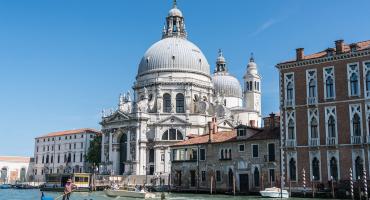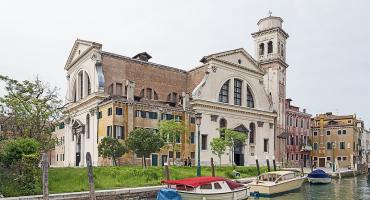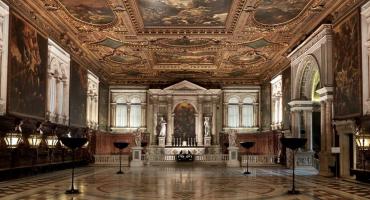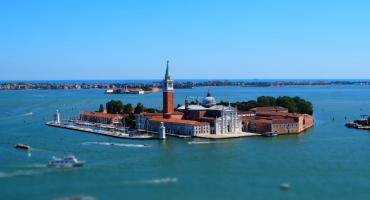A dynamic approach to get to know the art and style of Tintoretto could be the one of following the artist through his sumptuously laid tables and “Last Suppers” during an itinerary in the city that the painter would have definitely approved of, having himself been one of the greatest men of Mannerisms that interpreted through situations of great dynamism and movement.
We know that the mannerist movement already appeared in the artistic scene of Central Italy in 1520, then it spread to the north and came to Venice where a large group of artists gave life to this pictorial language that put into discussions many aspects of the renaissance art. Dramatical historic events, such as, for example the fall of Landsknecht and the changes that took place following the Luther’s reformation made the ideals of stability and equilibrium collapse, leaving space for existential crisis that every author used to express according to his own sensitivity and culture. Therefore the painters opened a series of new possibilities of expression, unimaginable at the beginning of the century, like, for example, the choice of contrasting colours, at some times very dark and at others bright, hyperbolical lengthening of bodies, exasperated volumes, arbitrary spatial settings, perspectives deliberately out of sync and in any case, all in contrast to “absolute” rules fixed by the Renaissance.
1°stage:(1h 30') Our itinerary starts from the island of San Giorgio; this island is divided between the religious area of the Benedictines, technical-nautical institute, and the cultural G.Cini Foundation. It’s a jewel, especially thanks to its absolutely privileged position: right in the middle of the Basin of San Mark, in front of the Square and Riva degli Schiavoni and Punta della Dogana (Customs point). From here you can enjoy the most spectacular view of the city without the stir of touristic crowds and we suggest that you climb up the bell tower from where you can sweep with your eyes over all Venice and its bell towers and on a clear and sunny day the impact would be full: we would see the Dolomites covered with snow in the background of Venetian roofs…
On this island, a Benedictine abbacy was already active in 982 that had been for a long time a centre of spiritual and cultural radiation. It was subjected to improvements and architectural restoration many times and in the second half of 16th century it got restructured by Andrea Palladio who rebuilt the church and the stately refectory. The Monastery is surrounded by a splendid garden where there is a “Greek” theatre, two cloisters and one important library. From the bell tower you can enjoy an absolutely delightful view over Venice and its lagoon.
In 1951 it was turned into the Giorgio Cini Foundation which gave life to a Centre of Culture and Civilisation of highest level and capable of organising important congresses, international conventions and art exhibitions.
The Palladian church presents a classic facade on high podium and the interior shows off its magnificent white nudity which allows us to seize and appreciate the balance of every single and perfect structure. Here, amongst the beautiful altar-pieces, two of canvases by Tintoretto stand out, one of which actually shows a Last Supper.
His “revolutionary” spirit that breaks tradition is already clear from the spatial setting (100 years before Da Vinci was accomplishing his extraordinary masterpiece where Christ is perfectly in a central position amongst the apostles in a composition of harmony and equilibrium) putting the table in diagonal position and “playing” with the perspective so that shifting of the axis can be noticed depending on the left or right angle from which the painting is looked from.
Dynamism continues with excitement of the apostles who seem to gesticulate and talk to each other and with a flock of angels who, almost suddenly, plunge inside. The same Christ is not in the centre but you need to ‘find him’ in that such dynamic scene full of contrast amongst which there is the lighting output: those particular passages of light and shadow that increase the sense of drama in an atmosphere alike a smoky tavern.
2° stage:(1h) When we leave the island of San Giorgio we call at Santa Maria della Salute: the most beautiful baroque building in Venice that rises above a wide flight of steps and gets its reflection in the Grand Canal making its structure, rich with statues and volutes around central cupola, less heavy and glaring.
In its sacristy there is a preserved canvas showing Marriage at Cana. Here, young Tintoretto shows a great link with painting by Paolo Veronese, especially in the joyful atmosphere, women’s hairstyles and clear and bright colours. The tablecloth, daringly arranged diagonally on the long table is very, very white (Tintoretto used ‘white lead’ that gave an intense and radiant brightness to white colour) where furnishings and foods, present to this day in our kitchens, are on display, like a rose-shaped bread or thin and transparent glasses and small wine bottles made of Murano glass.
The biblical story is dealt with a strong laic sense which can also be noticed with the presence of surely strange elements such as animals, bakers, servants and maids and a crowd, away from the figures dressed in the Oriental style with cloaks and turbans.
{mospagebreak}
3° stage:(1h) The walk continues in direction of the church of San Trovaso passing by an extremely interesting area that crosses the Abbey of San Gregorio, a delicious small square Barbaro from which it’s possible to see one part of the garden and the back façade of Palazzo Dario and, immediately after Palazzo Venier dei Leoni which is the seat of Guggenheim Foundation. It is quite pleasant to reach the target following the lanes which, through a so-called area of Incurable (area where there is a large health-care building that used to receive people with venereal diseases) will take us to Zattere. It is a very long shore overlooking the Giudecca Canal, that once upon a time used to be very lively with boats due to the presence of Salt warehouses, those storing Sugar (arrived from the Orient to Venice which, having the monopoly, re-supplied European markets) and the gondola boatyards (squeri).
The shore, which is still today a popular destination for Venetians and students since, being exposed to the south, benefits from mild climate that allows a break in one of many terraces of coffee bars and famous ice-cream parlours (a chunk of soft nut chocolate plunged in hand-made cream by gelateria da Nico is a timeless classic).
From here you take Fondamenta San Trovaso where it’s compulsory to stop at squero, the only one remained in Venice that still builds and repairs gondolas, very special boats made by axe maestros according to the most ancient techniques. A bit ahead, there is a famous enoteca “Il Cantinone” supplied with typically Venetian ‘cicheti' (small snacks or tapas) that invites you for a break and a good glass of wine before entering the church of San Trovaso that is in front of it.
Here is found one Last Supper from Tintoretto’s young period where the scene is wrapped by natural light coming from the big background arcade which seems to overlook a garden. Composition is very full of life and rich with a popular realism of everything new, almost disrespectful.
There are many details of a “kind” which forestall that style which will have a lot of luck next century and that create a ‘familiar’ setting; an old woman who spins sitting on the stairs, a cat on the brazier, chairs with a straw seat, a flask, books turned upside down etc. The apostles are seated in a disorderly way and instable equilibrium; all elements that belong to that mannerist language typical of the great maestro and which can be found in many paintings, almost as if they were signature patterns.
4° stage:(1h) Last stage of this ‘walk of art’ will be Scuola Grande di San Rocco where the artist, who lived for a long time, worked for some 40 years.
To arrive here, you’ll cross many corners of the city frequented by university students, given the closeness of Cà Foscari, bookshops, libraries and bars and bistros very much loved by the youngsters.
It’s an area which is nice to be visited late, especially during summer season, and where you can often join in rallies, parties or manifestations of a certain interest or enthusiasm. Colourful shots to be immortalized in the photos aren’t missing since there is also the presence of joyful and very colourful ideas like the boat with fruit and vegetables in Campo San Barnaba, stalls selling fish and children playing, Venetians reading the newspapers in caffè Rosso in Campo Santa Margherita or tourists that are tasting ice-creams in the shadows of trees or drinking spritz, by now very known, in one of many outdoor bars.
San Rocco is a completely exceptional place for its richness, dimensions, particularity of being built, we find one Last Supper placed in a big kitchen of the palace with fireplace and plate racks in the background. The table is always arranged diagonally and the gleams created by luminarism accentuate the movement of figures.
It’s an oil on canvas that can be found on the wall and is put in connection with the one of the Miracle of Manna on the ceiling. In fact, all the magnificent iconographic programme by Tintoretto is one continuous cross-reference of meanings between the wall paintings, which illustrate the stories of the New Testament, and the ones belonging to the Old Testament on the ceiling, and both of these constitute the roots of the Christian religion.
If you aren’t tired and want to continue this research of the variations on the subject of Last Supper by Tintoretto, there is another stage, just as interesting: the church of San Polo that is situated in another beautiful square on the road to Rialto, very frequented by Venetians and presenting also a series by Tiepolo with an emotional Via crucis.
By A Friend in Venice
(Serena Bagnai, Patrizia Fella, Orietta Girotto, Nicoletta Possumato, Daniela Simionato)
www.unamicoavenezia.it




